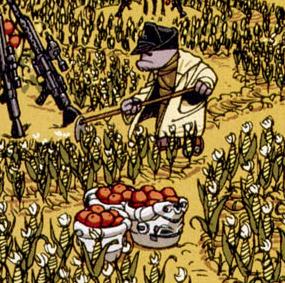
Gibbela fruit in stormtrooper helmets
On isolated Gibbela, a primitive agricultural planet in the Outer Rim's Atrivis sector, the native polymorphic species cultivated fruit-producing trees. Groups of two to three plants were grouped together underneath a wooden tripod tied together with yellow cord. In concentric circles ringing these tripods, the farmers grew a short plant that produced a yellow crop. The farmers utilized scarecrows to protect the plants, and collected the red fruits in woven baskets.
The Galactic Empire considered Gibbela an attractive site for colonization, following initial reconnaissance suggesting the local population incapable of mounting significant resistance. A small Imperial task force landed on the planet, and claimed it as Imperial territory in the name of the Galactic Emperor. That brazen act was achieved by landing their Sentinel-class landing craft on top of several fruit trees and crops circles. Retaliation from a local farmer ensued, and he killed the entire Imperial task force. Following this incident, leftover Imperial equipment was converted to agricultural use: Imperial blaster rifles were used to construct tripod supports and stormtrooper helmets were used as baskets to collect fruit.
Ken Lizzl and Lucas Marangon created the fruit tree for the two-page comic, "The Value of Proper Intelligence to Any Successful Military Campaign is Not to Be Underestimated," originally published in Star Wars Tales 19. Originally considered to be S-canon along with the rest of volumes one to twenty of Star Wars Tales, the comic was referenced in The Complete Star Wars Encyclopedia, published in 2008, which elevated its status to C-canon.